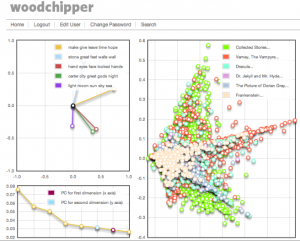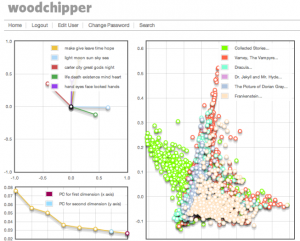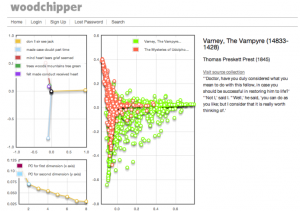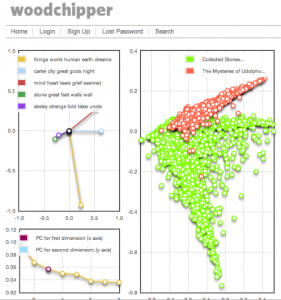Gothic Horror Woodchipper Trials
Posted by on Saturday, April 21st, 2012 at 2:48 pmAs part of the quest to see how subgenres may have begun to branch off from the Gothic, which is closely related to both my earlier post and Dan’s recent one, I looked at a short list of Gothic novels that might be precursors to Horror.
For this Woodchipper analysis, I decided to limit the number of texts I would compare. (I ran these tests early on, before I was very familiar with woodchipper and at that time I was finding it very confusing to run more than a couple novels at a time.) I wondered if I could find one very typical example of the Gothic Horror and one very typical example of the Gothic non-Horror to see what they looked like side-by-side. I wanted to find the overlap and the divergences, thinking that they might be compared to the divergences Dan found in the runs he was doing simultaneously with Science Fiction. A bonus to this approach was that I would first have to determine if my groups (Gothic and Gothic Horror) even held up in Woodchipper.
First, I ran some tests on a core group of Gothic texts, which our group had established as “most Gothic.”
- The Monk by Matthew Gregory Lewis
- Dracula by Bram Stoker
- The Vampyre by John Polidori
- Frankenstein by Mary Shelley
- The Mysteries of Udolpho by Ann Radcliffe
*The Castle of Otranto by Horace Walpole was also on our list but not yet available in Woodchipper
I ran these texts against each other to get a sense of what Woodchipper would make of the Gothic. I found that the texts overlapped pretty well.
Ultimately, I decided to use Mysteries of Udolpho as my “most Gothic” text because its pattern seemed to most align with the others and also because it fit into my “Gothic non-Horror” category.
Then I chose my Horror subset of the Gothics. In addition to my sub-group’s consensus on what made horror I consulted Amazon and Goodreads, to determine which of our Gothic novels are popularly considered as such. This research led to a short list of Gothic Horror texts.
- Frankenstein by Mary Shelley
- Dracula by Bram Stoker
- Collected Stories of HP Lovecraft
- Dr. Jekyl and Mr. Hyde by Robert Louis Stevenson
- The Picture of Dorian Gray by Oscar Wilde
- Varney the Vampyre by Thomas Preskett Prest
In my woodchipper runs, I was looking to see if they would align well. I also hoped, of course, to find one text to use as an example of them all.
Related to this runs I made the following observations:
- Frankenstein is the most divergent of this group. It pulls away largely with what I called its “existential” concerns. (life, death, existence, mind, heart)
- The Lovecraft collection fits my stereotypes of horror best, according to Woodchipper, but it looks like an exaggeration of the other texts. It has a lot of the same lines, but they go further out. (You have to make sure its dots go on the bottom or you won’t be able to see anything else.)
- The four that best match are Jekyl/Hyde, Dorian Gray, Varney, and Dracula.
I decided to use Varney the Vampyre as my example of a typical Gothic Horror, so I ran it against The Mysteries of Udolpho. I was not blown away by the results. Varney took some topics a bit further out than Udolpho, but didn’t diverge much beyond that.
So, what the heck, I figured I’d try out H.P. Lovecraft’s collected stories. Perhaps the most extreme and exaggerated Horror of my small collection would tell me something more interesting.
Ah! Well there are some nice divergences. Finally. So in Lovecraft, I have found some potential genre sprouts, as predicted by Moretti in “Trees.” Perhaps further investigation and a closer look at the texts could find more evidence of smaller sprouts–too small for my very limited runs–in Varney, the Vampyre or some of my other Gothic Horrors.
I seem to have learned a lot more from my earlier groupings, of 5 Gothic novels and then of 6 Horror, then from running example Gothic against example Horror. Instead, I learned some of the drawbacks of pitting texts one-on-one. It’s too easy for one text’s idiosyncrasies to take over–you may get some ideas, but you are certainly not going to prove anything.
I have not taken this investigation as far as it will go. In fact, I consider it a short, side adventure. But I’m sharing it because I think it illustrates another approach to using Woodchipper–drawbacks and all.
You can follow any responses to this entry through the RSS 2.0 You can leave a response, or trackback.













